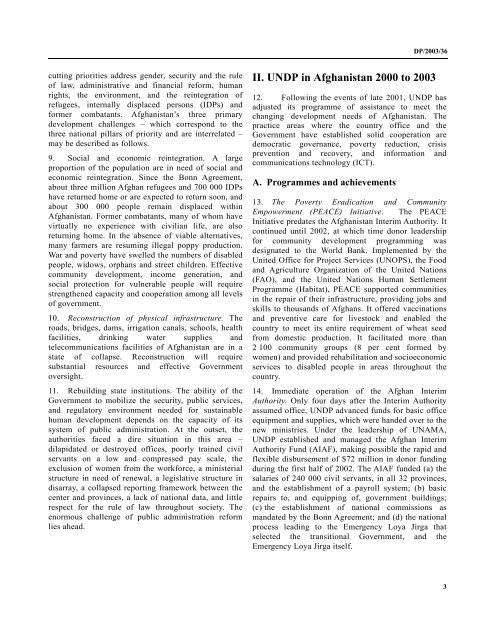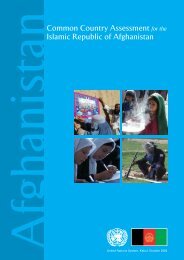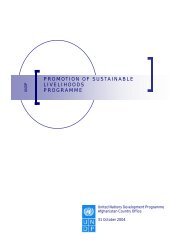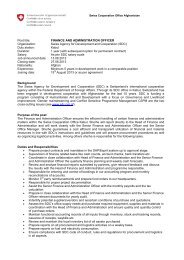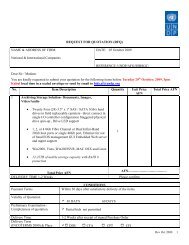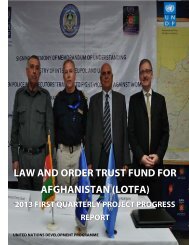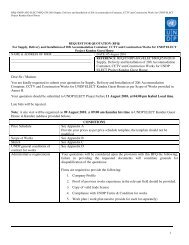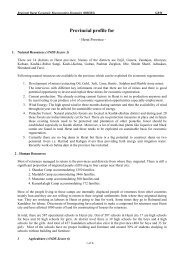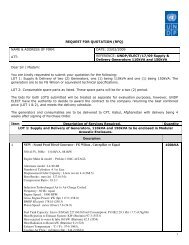UNDP Country Programme for Afghanistan 2004-2005
UNDP Country Programme for Afghanistan 2004-2005
UNDP Country Programme for Afghanistan 2004-2005
Create successful ePaper yourself
Turn your PDF publications into a flip-book with our unique Google optimized e-Paper software.
DP/2003/36<br />
cutting priorities address gender, security and the rule<br />
of law, administrative and financial re<strong>for</strong>m, human<br />
rights, the environment, and the reintegration of<br />
refugees, internally displaced persons (IDPs) and<br />
<strong>for</strong>mer combatants. <strong>Afghanistan</strong>’s three primary<br />
development challenges – which correspond to the<br />
three national pillars of priority and are interrelated –<br />
may be described as follows.<br />
9. Social and economic reintegration. A large<br />
proportion of the population are in need of social and<br />
economic reintegration. Since the Bonn Agreement,<br />
about three million Afghan refugees and 700 000 IDPs<br />
have returned home or are expected to return soon, and<br />
about 300 000 people remain displaced within<br />
<strong>Afghanistan</strong>. Former combatants, many of whom have<br />
virtually no experience with civilian life, are also<br />
returning home. In the absence of viable alternatives,<br />
many farmers are resuming illegal poppy production.<br />
War and poverty have swelled the numbers of disabled<br />
people, widows, orphans and street children. Effective<br />
community development, income generation, and<br />
social protection <strong>for</strong> vulnerable people will require<br />
strengthened capacity and cooperation among all levels<br />
of government.<br />
10. Reconstruction of physical infrastructure. The<br />
roads, bridges, dams, irrigation canals, schools, health<br />
facilities, drinking water supplies and<br />
telecommunications facilities of <strong>Afghanistan</strong> are in a<br />
state of collapse. Reconstruction will require<br />
substantial resources and effective Government<br />
oversight.<br />
11. Rebuilding state institutions. The ability of the<br />
Government to mobilize the security, public services,<br />
and regulatory environment needed <strong>for</strong> sustainable<br />
human development depends on the capacity of its<br />
system of public administration. At the outset, the<br />
authorities faced a dire situation in this area –<br />
dilapidated or destroyed offices, poorly trained civil<br />
servants on a low and compressed pay scale, the<br />
exclusion of women from the work<strong>for</strong>ce, a ministerial<br />
structure in need of renewal, a legislative structure in<br />
disarray, a collapsed reporting framework between the<br />
center and provinces, a lack of national data, and little<br />
respect <strong>for</strong> the rule of law throughout society. The<br />
enormous challenge of public administration re<strong>for</strong>m<br />
lies ahead.<br />
II. <strong>UNDP</strong> in <strong>Afghanistan</strong> 2000 to 2003<br />
12. Following the events of late 2001, <strong>UNDP</strong> has<br />
adjusted its programme of assistance to meet the<br />
changing development needs of <strong>Afghanistan</strong>. The<br />
practice areas where the country office and the<br />
Government have established solid cooperation are<br />
democratic governance, poverty reduction, crisis<br />
prevention and recovery, and in<strong>for</strong>mation and<br />
communications technology (ICT).<br />
A. <strong>Programme</strong>s and achievements<br />
13. The Poverty Eradication and Community<br />
Empowerment (PEACE) Initiative. The PEACE<br />
Initiative predates the <strong>Afghanistan</strong> Interim Authority. It<br />
continued until 2002, at which time donor leadership<br />
<strong>for</strong> community development programming was<br />
designated to the World Bank. Implemented by the<br />
United Office <strong>for</strong> Project Services (UNOPS), the Food<br />
and Agriculture Organization of the United Nations<br />
(FAO), and the United Nations Human Settlement<br />
<strong>Programme</strong> (Habitat), PEACE supported communities<br />
in the repair of their infrastructure, providing jobs and<br />
skills to thousands of Afghans. It offered vaccinations<br />
and preventive care <strong>for</strong> livestock and enabled the<br />
country to meet its entire requirement of wheat seed<br />
from domestic production. It facilitated more than<br />
2 100 community groups (8 per cent <strong>for</strong>med by<br />
women) and provided rehabilitation and socioeconomic<br />
services to disabled people in areas throughout the<br />
country.<br />
14. Immediate operation of the Afghan Interim<br />
Authority. Only four days after the Interim Authority<br />
assumed office, <strong>UNDP</strong> advanced funds <strong>for</strong> basic office<br />
equipment and supplies, which were handed over to the<br />
new ministries. Under the leadership of UNAMA,<br />
<strong>UNDP</strong> established and managed the Afghan Interim<br />
Authority Fund (AIAF), making possible the rapid and<br />
flexible disbursement of $72 million in donor funding<br />
during the first half of 2002. The AIAF funded (a) the<br />
salaries of 240 000 civil servants, in all 32 provinces,<br />
and the establishment of a payroll system; (b) basic<br />
repairs to, and equipping of, government buildings;<br />
(c) the establishment of national commissions as<br />
mandated by the Bonn Agreement; and (d) the national<br />
process leading to the Emergency Loya Jirga that<br />
selected the transitional Government, and the<br />
Emergency Loya Jirga itself.<br />
3


